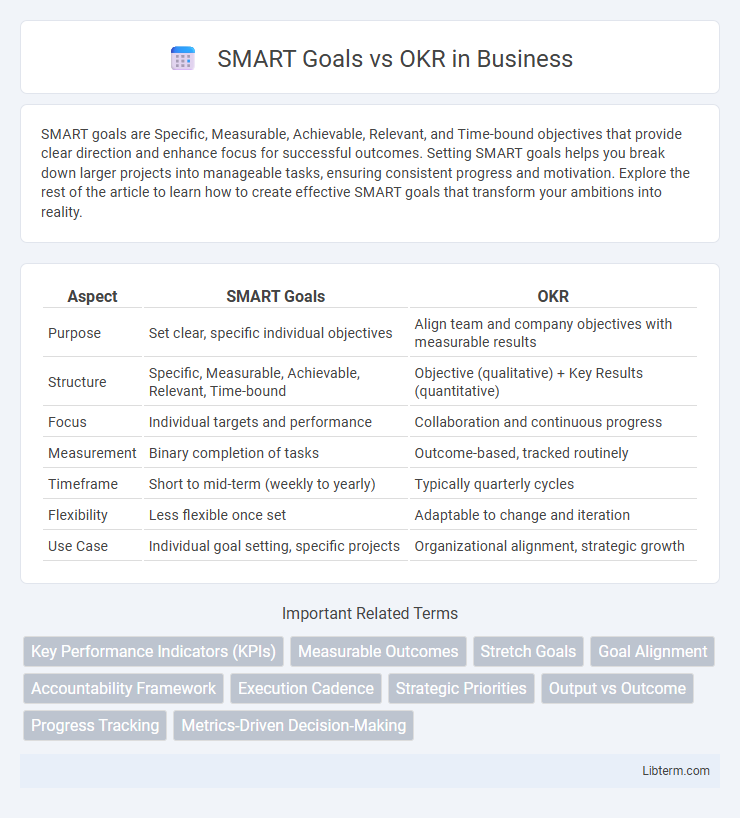SMART goals are Specific, Measurable, Achievable, Relevant, and Time-bound objectives that provide clear direction and enhance focus for successful outcomes. Setting SMART goals helps you break down larger projects into manageable tasks, ensuring consistent progress and motivation. Explore the rest of the article to learn how to create effective SMART goals that transform your ambitions into reality.
Table of Comparison
| Aspect | SMART Goals | OKR |
|---|---|---|
| Purpose | Set clear, specific individual objectives | Align team and company objectives with measurable results |
| Structure | Specific, Measurable, Achievable, Relevant, Time-bound | Objective (qualitative) + Key Results (quantitative) |
| Focus | Individual targets and performance | Collaboration and continuous progress |
| Measurement | Binary completion of tasks | Outcome-based, tracked routinely |
| Timeframe | Short to mid-term (weekly to yearly) | Typically quarterly cycles |
| Flexibility | Less flexible once set | Adaptable to change and iteration |
| Use Case | Individual goal setting, specific projects | Organizational alignment, strategic growth |
Introduction to SMART Goals and OKRs
SMART Goals are specific, measurable, achievable, relevant, and time-bound objectives designed to provide clear direction and trackable progress. OKRs (Objectives and Key Results) focus on setting ambitious, qualitative objectives paired with quantifiable key results to drive organizational alignment and performance. Both frameworks enhance goal-setting efficiency but differ in scope, with SMART goals targeting individual tasks and OKRs enabling strategic, cross-functional outcomes.
Defining SMART Goals: Key Components
SMART goals are defined by five key components: Specific, Measurable, Achievable, Relevant, and Time-bound criteria that ensure clear and actionable objectives. Each element focuses on creating goals that provide clarity, track progress with quantifiable indicators, maintain realistic expectations aligned with broader aims, and establish a deadline for completion. This structured framework enhances goal-setting effectiveness, fostering accountability and targeted achievement.
Understanding OKRs: Objectives and Key Results
OKRs (Objectives and Key Results) drive organizational alignment by setting clear, ambitious objectives paired with measurable key results that track progress and outcomes. Unlike SMART Goals, which focus on specific, measurable, achievable, relevant, and time-bound criteria for individual tasks, OKRs emphasize transparency and continuous improvement through regular check-ins and updates. This framework enhances goal-setting by fostering a results-oriented culture that encourages collaboration and agility across teams.
Comparing SMART Goals and OKRs: Core Differences
SMART Goals emphasize specificity, measurability, achievability, relevance, and time-bound criteria to create clear, actionable objectives, focusing on individual or team task completion. OKRs (Objectives and Key Results) combine aspirational objectives with measurable key results, promoting alignment and continuous performance tracking across organizational levels. The core difference lies in SMART's detailed goal-setting framework versus OKR's broader approach fostering transparency, agility, and collective progress toward strategic outcomes.
Advantages of Using SMART Goals
SMART Goals provide clear, specific, and measurable criteria that enhance focus and accountability, driving consistent progress. Their simplicity makes them accessible for individual and team use, ensuring objectives are attainable and time-bound, which boosts motivation and performance. Organizations benefit from the structured framework of SMART Goals, leading to improved clarity and efficient resource allocation.
Benefits of Implementing OKRs
Implementing OKRs (Objectives and Key Results) drives alignment by clearly defining measurable goals across teams, enhancing transparency and accountability. OKRs foster continuous performance tracking through regular check-ins, enabling agile adjustments and sustained focus on high-impact priorities. This results in improved employee engagement and a stronger connection between individual efforts and organizational success.
Choosing Between SMART Goals and OKRs
Choosing between SMART Goals and OKRs depends on organizational needs; SMART Goals emphasize Specific, Measurable, Achievable, Relevant, and Time-bound objectives for individual task completion, while OKRs (Objectives and Key Results) focus on setting ambitious objectives linked to measurable key results promoting alignment and transparency across teams. SMART Goals work best for clear, short-term targets requiring precise benchmarks, whereas OKRs foster continuous improvement and innovation through stretch goals and regular check-ins. Companies aiming for structured, individual performance tracking may prefer SMART, while those seeking agile, collaborative progress often adopt OKRs for dynamic goal management.
Best Practices for Setting SMART Goals
Setting SMART goals involves ensuring objectives are Specific, Measurable, Achievable, Relevant, and Time-bound to drive clear progress and accountability. Best practices include defining precise metrics for success, aligning goals with broader organizational priorities, and setting realistic deadlines to maintain motivation and track performance effectively. Compared to OKRs, SMART goals offer a more structured and detailed framework, ideal for individual or team goal-setting where clarity and measurability are paramount.
Effective OKR Implementation Strategies
Effective OKR implementation strategies prioritize clear alignment of Objectives with measurable Key Results to drive organizational focus and accountability. Regular check-ins, transparent progress tracking, and cross-functional collaboration ensure teams stay engaged and adaptive to changing priorities. Integrating OKRs with company-wide goals enhances motivation and fosters a culture of continuous improvement and performance excellence.
Integrating SMART Goals and OKRs for Maximum Impact
Integrating SMART Goals and OKRs combines the precise, measurable criteria of SMART with the ambitious, outcome-focused framework of OKRs to drive clarity and alignment in organizational objectives. Utilizing SMART's Specific, Measurable, Achievable, Relevant, and Time-bound criteria within OKRs ensures key results are actionable and trackable, enhancing accountability. This synergy fosters strategic focus, motivating teams to achieve impactful outcomes through well-defined milestones and continuous progress monitoring.
SMART Goals Infographic

 libterm.com
libterm.com